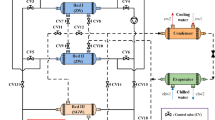Abstract
Ecological adsorption technology is becoming a focus of attention by industry due to the utilization of low grade thermal energy sources for cooling production. It can be a promising part of sustainable development concept of the global economy. Therefore, research aiming at improving their performance i.e. Coefficient of Performance (COP) by optimizing the construction of sorption beds with a built in heat exchanger system is crucial. The heat transfer characteristics between the bed of porous media (sorbent) and surface of the heat exchanger system determine the heating power of an adsorption chiller. The HP increase can be obtained by heat transfer intensification due to the increase in the thermal conductivity of the sorbent layer in the vicinity of the heat exchanger’s surface. The novel modification of the sorbent layer structure is proposed in the paper in order to improve the heat transfer processes in the heat exchanger boundary layer. The analysis of desorption process conditions in the parametric model of a coated and fixed adsorption bed design is presented in the paper. The computational fluid dynamics (CFD) with conjugate heat transfer analysis is used to determine the crucial input parameters (temperature distribution in the sorbent bed) for further analytical calculations. The commercial code Ansys Fluent was used to perform numerical simulations. The developed computational model consisted of three subdomains representing heating water, heat exchanger material (copper) and sorbent (silica gel). The comparison of a novel coated design and a conventional fixed bed is discussed in the paper. The numerical analysis is based on experimental thermal conductivity measurements of the sorbent layer in different configurations, which were performed using Laser Flash Method.
Similar content being viewed by others
References
Krzywanski J., Grabowska K., Herman F., Pyrka P., Sosnowski M., Prauzner T., Nowak W.. Optimization of a three-bed adsorption chiller by genetic algorithms and neural networks. Energy Conversion and Management, 2017, 153: 313–322.
Khan M.Z.I., Alam K.C.A., Saha B.B., Hamamoto Y., Akisawa A., Kashiwagi T.. Parametric study of a two-stage adsorption chiller using re-heat - The effect of overall thermal conductance and adsorbent mass on system performance, International Journal of Thermal Sciences, 2006, 45(5): 511–519.
Sztekler K., Kalawa W., Nowak W., Stefański S., Krzywanski J., Grabowska K.. Using the adsorption chillers for utilization of waste heat from rotary kilns. International Conference on Experimental Fluid Mechanics, Mikulov, Czech Republic, 2017: 650–653.
Stanek W., Gazda W., Kostowski W.. Thermo- ecological assessment of CCHP (combined cold-heat- and-power) plant supported with renewable energy. Energy, 2015, 92: 279–289.
Demir H., Mobedi M., Ulku, S.. The use of metal piece additives to enhance heat transfer rate through an unconsolidated adsorbent bed. International Journal of Refrigeration, 2010, 33(4): 714–720.
Jiang Y., Ge T.S., Wang R.Z., Hu L.M.. Experimental investigation and analysis of composite silica-gel coated fin-tube heat exchangers. International Journal of Refrigeration, 2015, 51: 169–179.
Grabowska K., Krzywanski J., Nowak W., Wesolowska, M.. Construction of an innovative adsorbent bed configuration in the adsorption chiller - Selection criteria for effective sorbent-glue pair. Energy, 2018, 151: 317–323.
Aristov Y.I., Glaznev I.S., Girnik I.S.. Optimization of adsorption dynamics in adsorptive chillers: Loose grains configuration. Energy, 2012, 46(1): 484–492.
Lu Z.S., Wang R.Z., Xia, Z.Z.. Experimental analysis of an adsorption air conditioning with micro-porous silica gel-water. Applied Thermal Engineering, 2013 50(1): 1015–1020.
Krzywanski J., Nowak W.. Modeling of bed- to-wall heat transfer coefficient in a large-scale CFBC by fuzzy logic approach. International Journal of Heat and Mass Transfer, 2016 94: 327–334.
Gnatowski A., Sosnowski M., Pajdak A., Sobczyk J.. Experimental study of thermal effects in cooling of circular cylinder in lock-on conditions. Advances in Science and Technology Research Journal, 2018, 12(2): 42–51.
Sosnowski M., Krzywański J., Grabowska K., Gnatowska R.. Polyhedral meshing in numerical analysis of conjugate heat transfer. International Conference on Experimental Fluid Mechanics, Mikulov, Czech Republic, 2017: 589–594.
Muhammad A., Arshad H.. Computational fluid dynamics (CFD) modeling of heat transfer in a polymeric membrane using finite volume method. Journal of Thermal Science, 2016, 25(6): 564–570.
Sosnowski M.. Computational domain discretization in numerical analysis of flow within granular materials. International Conference on Experimental Fluid Mechanics, Mikulov, Czech Republic, 2017: 582–588.
Sosnowski M.. Computational domain discretization in numerical analysis of forced convective heat transfer within packed beds of granular materials. International Conference on Engineering Mechanics, Svratka, Czech Republic, 2018: 801–804.
Chunsheng G., Xianbo N., Yong L., Chao Q., Jinsheng S., Wenhe Y.. Analysis of 2D flow and heat transfer modeling in fracture of porous media. Journal of Thermal Science, 2017, 26(4): 331–338
Jribi S., Miyazaki T., Saha B.B., Koyama S., Maeda S., Maruyama T.. CFD simulation and experimental validation of ethanol adsorption onto activated carbon packed heat exchanger. International Journal of Refrigeration, 2017, 74: 345–353.
https://www.netzsch-thermal-analysis.com/ (accessed 30 April 2018)
Hobler T. Ruch ciepła i wymienniki. Wydawnictwa Naukowo-Techniczne, Warszawa, 1986, pp. 36–57. (in Polish)
Acknowledgments
Scientific work was performed within the project: “The development of innovative technology of adsorption chiller NETI®, using special, glued construction of the adsorption beds” (number: POIR.01.01.01-00-1659/ 15) it was partially supported by National Science Centre of Poland (Narodowe Centrum Nauki) grant number 2017/01/X/ST8/00019 as well as subsidies granted by the Faculty of Mathematics and Natural Sciences of Jan Dlugosz University in Czestochowa. The support is gratefully acknowledged.
Author information
Authors and Affiliations
Corresponding author
Rights and permissions
About this article
Cite this article
Grabowska, K., Sosnowski, M., Krzywanski, J. et al. The Numerical Comparison of Heat Transfer in a Coated and Fixed Bed of an Adsorption Chiller. J. Therm. Sci. 27, 421–426 (2018). https://doi.org/10.1007/s11630-018-1035-y
Received:
Published:
Issue Date:
DOI: https://doi.org/10.1007/s11630-018-1035-y




